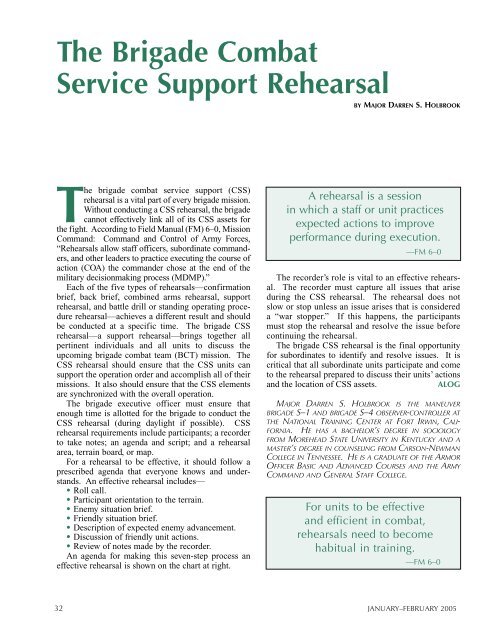Supporting the First Stryker Brigade in Iraq - Army Logistics ...
Supporting the First Stryker Brigade in Iraq - Army Logistics ...
Supporting the First Stryker Brigade in Iraq - Army Logistics ...
Create successful ePaper yourself
Turn your PDF publications into a flip-book with our unique Google optimized e-Paper software.
The <strong>Brigade</strong> Combat<br />
Service Support Rehearsal<br />
The brigade combat service support (CSS)<br />
rehearsal is a vital part of every brigade mission.<br />
Without conduct<strong>in</strong>g a CSS rehearsal, <strong>the</strong> brigade<br />
cannot effectively l<strong>in</strong>k all of its CSS assets for<br />
<strong>the</strong> fight. Accord<strong>in</strong>g to Field Manual (FM) 6–0, Mission<br />
Command: Command and Control of <strong>Army</strong> Forces,<br />
“Rehearsals allow staff officers, subord<strong>in</strong>ate commanders,<br />
and o<strong>the</strong>r leaders to practice execut<strong>in</strong>g <strong>the</strong> course of<br />
action (COA) <strong>the</strong> commander chose at <strong>the</strong> end of <strong>the</strong><br />
military decisionmak<strong>in</strong>g process (MDMP).”<br />
Each of <strong>the</strong> five types of rehearsals—confirmation<br />
brief, back brief, comb<strong>in</strong>ed arms rehearsal, support<br />
rehearsal, and battle drill or stand<strong>in</strong>g operat<strong>in</strong>g procedure<br />
rehearsal—achieves a different result and should<br />
be conducted at a specific time. The brigade CSS<br />
rehearsal—a support rehearsal—br<strong>in</strong>gs toge<strong>the</strong>r all<br />
pert<strong>in</strong>ent <strong>in</strong>dividuals and all units to discuss <strong>the</strong><br />
upcom<strong>in</strong>g brigade combat team (BCT) mission. The<br />
CSS rehearsal should ensure that <strong>the</strong> CSS units can<br />
support <strong>the</strong> operation order and accomplish all of <strong>the</strong>ir<br />
missions. It also should ensure that <strong>the</strong> CSS elements<br />
are synchronized with <strong>the</strong> overall operation.<br />
The brigade executive officer must ensure that<br />
enough time is allotted for <strong>the</strong> brigade to conduct <strong>the</strong><br />
CSS rehearsal (dur<strong>in</strong>g daylight if possible). CSS<br />
rehearsal requirements <strong>in</strong>clude participants; a recorder<br />
to take notes; an agenda and script; and a rehearsal<br />
area, terra<strong>in</strong> board, or map.<br />
For a rehearsal to be effective, it should follow a<br />
prescribed agenda that everyone knows and understands.<br />
An effective rehearsal <strong>in</strong>cludes—<br />
• Roll call.<br />
• Participant orientation to <strong>the</strong> terra<strong>in</strong>.<br />
• Enemy situation brief.<br />
• Friendly situation brief.<br />
• Description of expected enemy advancement.<br />
• Discussion of friendly unit actions.<br />
• Review of notes made by <strong>the</strong> recorder.<br />
An agenda for mak<strong>in</strong>g this seven-step process an<br />
effective rehearsal is shown on <strong>the</strong> chart at right.<br />
32<br />
BY MAJOR DARREN S. HOLBROOK<br />
A rehearsal is a session<br />
<strong>in</strong> which a staff or unit practices<br />
expected actions to improve<br />
performance dur<strong>in</strong>g execution.<br />
—FM 6–0<br />
The recorder’s role is vital to an effective rehearsal.<br />
The recorder must capture all issues that arise<br />
dur<strong>in</strong>g <strong>the</strong> CSS rehearsal. The rehearsal does not<br />
slow or stop unless an issue arises that is considered<br />
a “war stopper.” If this happens, <strong>the</strong> participants<br />
must stop <strong>the</strong> rehearsal and resolve <strong>the</strong> issue before<br />
cont<strong>in</strong>u<strong>in</strong>g <strong>the</strong> rehearsal.<br />
The brigade CSS rehearsal is <strong>the</strong> f<strong>in</strong>al opportunity<br />
for subord<strong>in</strong>ates to identify and resolve issues. It is<br />
critical that all subord<strong>in</strong>ate units participate and come<br />
to <strong>the</strong> rehearsal prepared to discuss <strong>the</strong>ir units’ actions<br />
and <strong>the</strong> location of CSS assets. ALOG<br />
MAJOR DARREN S. HOLBROOK IS THE MANEUVER<br />
BRIGADE S–1 AND BRIGADE S–4 OBSERVER-CONTROLLER AT<br />
THE NATIONAL TRAINING CENTER AT FORT IRWIN, CALI-<br />
FORNIA. HE HAS A BACHELOR’S DEGREE IN SOCIOLOGY<br />
FROM MOREHEAD STATE UNIVERSITY IN KENTUCKY AND A<br />
MASTER’S DEGREE IN COUNSELING FROM CARSON-NEWMAN<br />
COLLEGE IN TENNESSEE. HE IS A GRADUATE OF THE ARMOR<br />
OFFICER BASIC AND ADVANCED COURSES AND THE ARMY<br />
COMMAND AND GENERAL STAFF COLLEGE.<br />
For units to be effective<br />
and efficient <strong>in</strong> combat,<br />
rehearsals need to become<br />
habitual <strong>in</strong> tra<strong>in</strong><strong>in</strong>g.<br />
—FM 6–0<br />
JANUARY–FEBRUARY 2005







